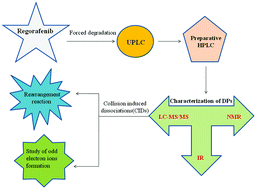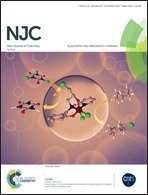Characterization of degradation products of regorafenib by LC-QTOF-MS and NMR spectroscopy: investigation of rearrangement and odd-electron ion formation during collision-induced dissociations under ESI-MS/MS†
Abstract
Regorafenib is an oral multikinase inhibitor, and it was subjected to stress conditions (hydrolysis, oxidative, thermal and photolytic) as per ICH specified conditions. The drug showed considerable degradation under hydrolysis (acidic, basic and neutral) and oxidative stress conditions, whereas it was stable under other stress conditions. A total of five degradation products (DPs) were observed and these were analyzed by using a UHPLC-DAD system. Chromatographic separation was achieved on an Acquity CSH C18 column (100 × 2.1 mm, 1.7 μ) using 0.1% formic acid and acetonitrile : methanol (80 : 20%, v/v) as the mobile phase in gradient mode. All DPs were characterized by LC-MS/MS, and the major degradation product (DP1) was isolated by using an HPLC preparative system from a degradation mixture and analyzed using NMR (1D and 2D NMR) and IR experiments. It was observed that protonated DP1 and DP3 undergo rearrangement reactions during collision-induced dissociations under positive electrospray ionization conditions. Additionally, in silico toxicity of the drug and its degradation products (DP1–DP5) was evaluated using TOPKAT and DEREK toxicity prediction software tools.



 Please wait while we load your content...
Please wait while we load your content...